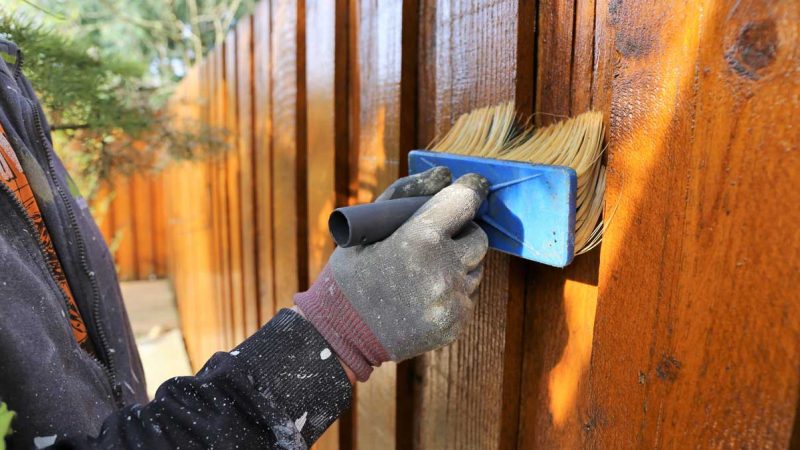When it comes to enhancing the beauty and longevity of your outdoor space, few things make as big of an impact as a well-maintained wood fence stain. A carefully chosen wood fence stain can not only add character and charm to your property but also provide essential protection against the elements. In this guide, we’ll delve into the intricacies of wood fence stain application, offering expert tips and techniques to help you achieve professional-quality results. From understanding your wood to selecting the perfect stain and mastering application methods, we’ll walk you through every step of the process for a flawless finish.
Wood Fence Stain: Understanding Your Wood – The Foundation of Success
Before diving into your staining project, it’s crucial to understand the type of wood you’re working with. Different wood species have varying porosities and characteristics that can affect how they absorb wood fence stain. Softwoods like cedar and pine tend to absorb stain more readily, while hardwoods such as oak and mahogany may require more preparation to achieve desired results.
Wood Fence Stain: Preparing Your Fence – The Key to Long-Lasting Results
Proper preparation is essential for ensuring the stain adheres evenly and penetrates deeply into the wood fibres. Start by thoroughly cleaning the fence surface to remove dirt, debris, and any existing coatings. Use a pressure washer or a stiff brush and mild detergent to scrub away grime and mould. Allow the fence to dry completely before proceeding to the next steps.
Wood Fence Stain: Choosing the Right Stain – Enhancing Beauty and Protection
Selecting the right stain is critical for achieving the desired look and providing adequate protection against the elements. Consider factors such as transparency (clear, semi-transparent, or solid), colour, and UV resistance when choosing your wood fence stain. Opt for high-quality stains specifically formulated for exterior wood surfaces to ensure durability and longevity.
Wood Fence Stain: Gathering Your Materials – Tools of the Trade
Before starting your staining project, gather all the necessary materials and tools. This includes wood fence stain, brushes or rollers, drop cloths, gloves, safety goggles, and any additional accessories such as stir sticks and paint trays. Having everything prepared and within reach will streamline the staining process and help prevent interruptions.
Wood Fence Stain: Cleaning and Repairing – Setting the Stage for Staining
Inspect the fence for any signs of damage, such as cracks, splinters, or loose boards. Repair any issues before proceeding with staining to ensure a smooth and uniform finish. Sand rough areas and remove any loose debris to create a clean and even surface for the stain to adhere to.
Wood Fence Stain: Protecting Surrounding Areas – Preventing Unwanted Stains
Before applying the stain, take precautions to protect surrounding vegetation, hardscapes, and other surfaces from accidental spills or overspray. Use drop cloths or plastic sheeting to cover nearby plants, grass, and paved areas. Mask off any adjacent surfaces with painter’s tape to create clean, crisp edges.
Wood Fence Stain: Applying the Stain – Techniques for Even Coverage
When it comes to applying the stain, consistency is key. Start by stirring the stain thoroughly to ensure uniform colour and consistency. Use a brush, roller, or sprayer to apply the stain in long, even strokes, working with the grain of the wood. Apply the stain generously, but avoid over-saturating the surface to prevent drips and runs.
Wood Fence Stain: Waiting and Drying – Patience Is Key
After applying the stain, allow sufficient time for it to penetrate into the wood and dry completely before applying additional coats or sealing. Factors such as temperature, humidity, and ventilation can affect drying times, so be patient and follow the manufacturer’s recommendations. Avoid walking on or touching the stained surface until it is fully dry to prevent smudges or blemishes.
Wood Fence Stain: Applying Additional Coats – Building Depth and Protection
Depending on the desired colour intensity and level of protection, you may need to apply multiple coats of stain. Allow each coat to dry thoroughly before applying the next, following the same application techniques as before. Additional coats will deepen the colour and enhance the durability of the finish, providing long-lasting protection against weathering and UV damage.
Wood Fence Stain: Sealing the Deal – Adding a Protective Finish
Once the final coat of stain has dried completely, consider adding a protective sealer or topcoat to further enhance the longevity of the finish. Choose a clear or tinted sealant specifically formulated for exterior wood surfaces to provide an extra layer of protection against moisture, UV rays, and mildew. Apply the sealer according to the manufacturer’s instructions, and allow it to dry thoroughly before enjoying your beautifully stained wood fence.
Conclusion
Achieving professional-quality results when staining your wood fence requires careful planning, preparation, and execution. By following the 10 foolproof steps outlined in this guide, you can ensure that your staining project delivers stunning results that will enhance the beauty and longevity of your fence for years to come.
FAQs
1. How often should I stain my wood fence?
Generally, it’s recommended to stain your wood fence every 2-3 years to maintain its appearance and protection against the elements. However, the frequency may vary depending on factors such as wood type, climate, and sun exposure.
2. Can I stain my fence in wet weather?
It’s best to avoid staining your fence during rainy or excessively humid conditions, as moisture can interfere with the staining process and affect the finish quality. Aim for dry, mild weather with moderate temperatures for optimal results.
3. Do I need to sand my fence before staining?
Sanding your fence before staining can help smooth out rough areas and remove any existing coatings or imperfections, resulting in a more uniform and professional-looking finish. However, if your fence is in good condition and free of rough spots, sanding may not be necessary.
4. How do I choose the right stain colour for my fence?
Consider factors such as your home’s exterior colour scheme, landscape design, and personal preference when selecting a stain colour. Test different shades on a small, inconspicuous area of your fence to see how they look in various lighting conditions before making a final decision.
5. Can I stain my fence myself, or should I hire a professional?
While staining a fence is a manageable DIY project for many homeowners, it does require careful preparation, attention to detail, and physical labour. If you’re comfortable with these aspects and have the necessary tools and skills, you can successfully stain your fence yourself. However, if you prefer to leave it to the experts or have a large or complex project, hiring a professional fence staining contractor may be a wise investment.
Also read: KITCHEN WORKTOP COVER MAGIC: 10 WAYS TO TRANSFORM YOUR SPACE









